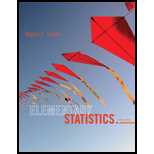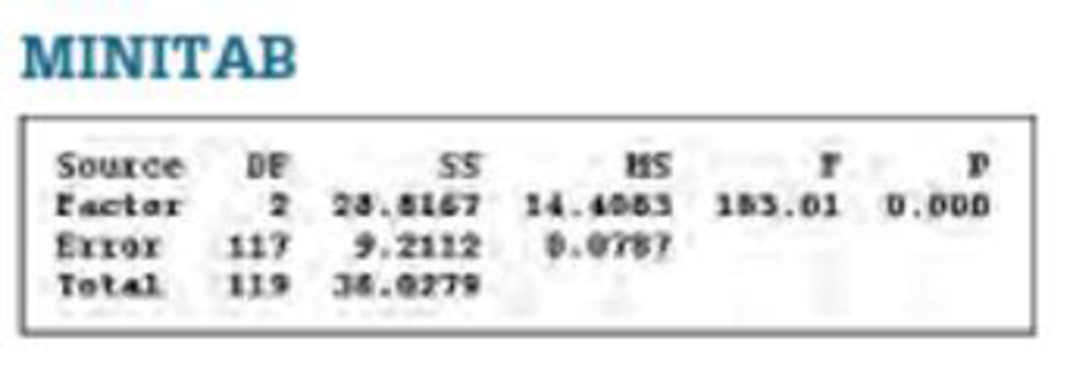
Measures of Voltage The author measured voltage amounts from three different sources: (1) electricity supplied directly to the author’s home, (2) an independent gas-powered Generac generator (model PP 5000), and (3) an uninterruptible power supply (APC model CS 350) connected to the author’s home power supply. The results from analysis of variance are shown below. What is the null hypothesis for this analysis of variance test? What specific result is used in deciding to reject H0 or fail to reject H0? Based on the displayed results, should you reject H0 or fail to reject H0?

To identify: The null hypothesis.
To explain: The specific result that is used in deciding to reject Ho and fail to reject Ho.
To check: Whether the null hypothesis is rejected or fails to reject by using the results.
Answer to Problem 1CQQ
The null hypothesis is,
The specific result that is used in deciding to reject Ho and fail to reject Ho is the decision rule based on P value.
The null hypothesis is rejected.
Explanation of Solution
Given info:
The Minitab output shows the result of analysis of variance for the voltage amounts from three different sources. The sources are electricity supplied directly to the author’s home, an independent gas-powered generac generator (model PP 5000) and an uninterruptible power supply (APC model CS 350).
Calculation:
State the test hypotheses.
Let
Null hypothesis:
Alternative hypothesis:
From the Minitab output, the P-value is 0.000.
Decision criteria for the P-value method:
If
If
Conclusion:
The P-value is 0.000 and the significance level is 0.05.
Here, the P-value is lesser than the significance level.
That is,
Here, the null hypothesis is rejected.
Thus, there is sufficient evidence to reject the claim that the mean voltage amounts from three sources are same.
Want to see more full solutions like this?
Chapter 12 Solutions
Elementary Statistics
- A company found that the daily sales revenue of its flagship product follows a normal distribution with a mean of $4500 and a standard deviation of $450. The company defines a "high-sales day" that is, any day with sales exceeding $4800. please provide a step by step on how to get the answers in excel Q: What percentage of days can the company expect to have "high-sales days" or sales greater than $4800? Q: What is the sales revenue threshold for the bottom 10% of days? (please note that 10% refers to the probability/area under bell curve towards the lower tail of bell curve) Provide answers in the yellow cellsarrow_forwardFind the critical value for a left-tailed test using the F distribution with a 0.025, degrees of freedom in the numerator=12, and degrees of freedom in the denominator = 50. A portion of the table of critical values of the F-distribution is provided. Click the icon to view the partial table of critical values of the F-distribution. What is the critical value? (Round to two decimal places as needed.)arrow_forwardA retail store manager claims that the average daily sales of the store are $1,500. You aim to test whether the actual average daily sales differ significantly from this claimed value. You can provide your answer by inserting a text box and the answer must include: Null hypothesis, Alternative hypothesis, Show answer (output table/summary table), and Conclusion based on the P value. Showing the calculation is a must. If calculation is missing,so please provide a step by step on the answers Numerical answers in the yellow cellsarrow_forward
 Glencoe Algebra 1, Student Edition, 9780079039897...AlgebraISBN:9780079039897Author:CarterPublisher:McGraw Hill
Glencoe Algebra 1, Student Edition, 9780079039897...AlgebraISBN:9780079039897Author:CarterPublisher:McGraw Hill Big Ideas Math A Bridge To Success Algebra 1: Stu...AlgebraISBN:9781680331141Author:HOUGHTON MIFFLIN HARCOURTPublisher:Houghton Mifflin Harcourt
Big Ideas Math A Bridge To Success Algebra 1: Stu...AlgebraISBN:9781680331141Author:HOUGHTON MIFFLIN HARCOURTPublisher:Houghton Mifflin Harcourt College Algebra (MindTap Course List)AlgebraISBN:9781305652231Author:R. David Gustafson, Jeff HughesPublisher:Cengage Learning
College Algebra (MindTap Course List)AlgebraISBN:9781305652231Author:R. David Gustafson, Jeff HughesPublisher:Cengage Learning



